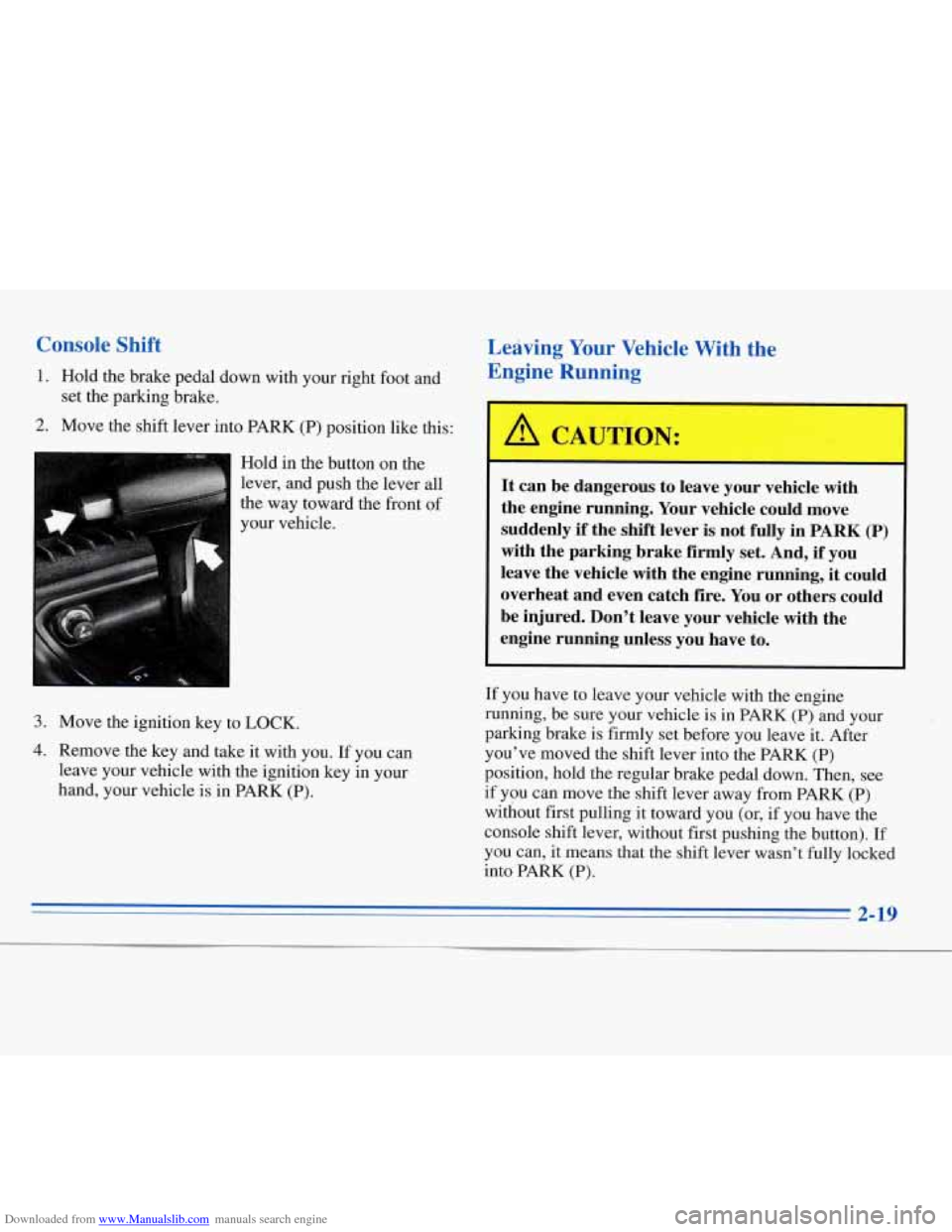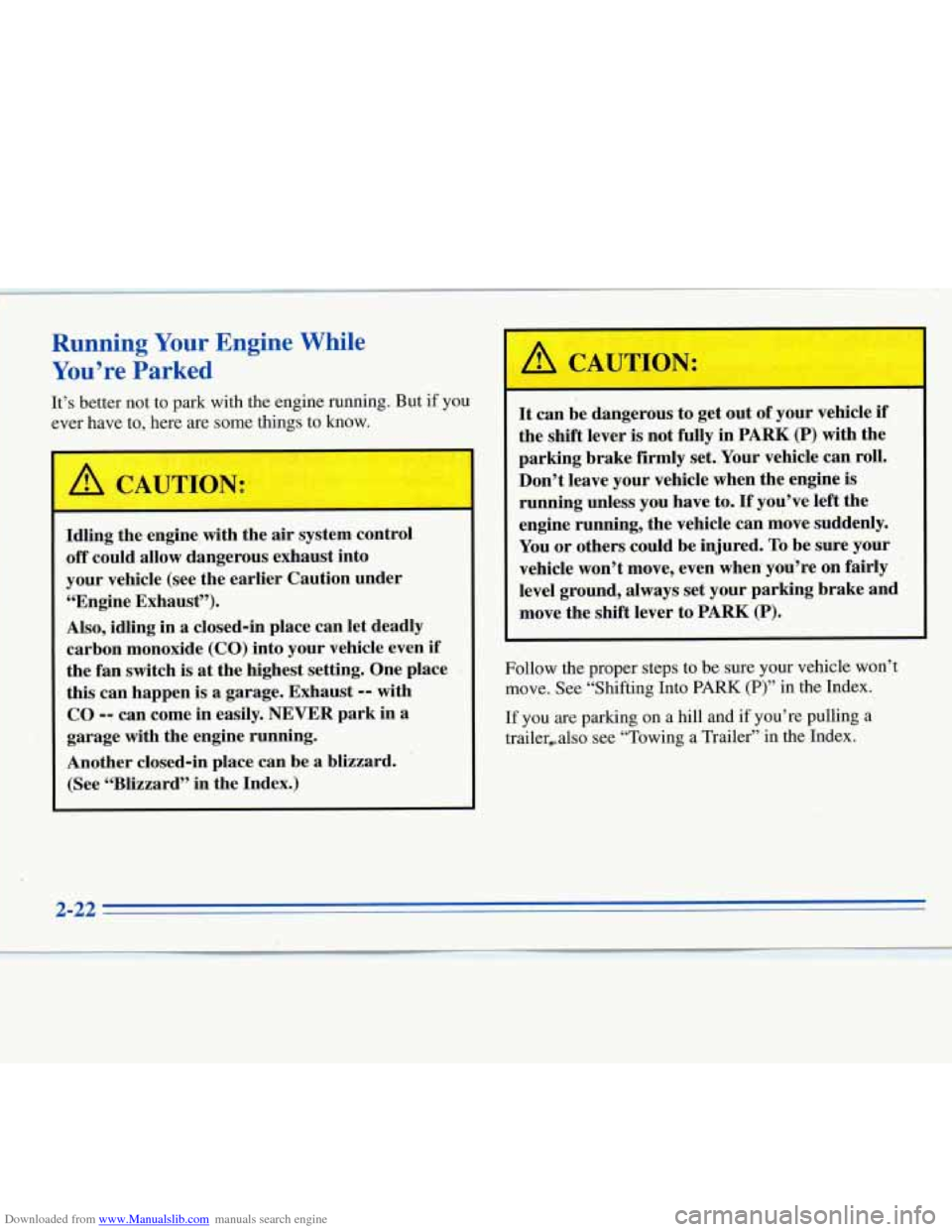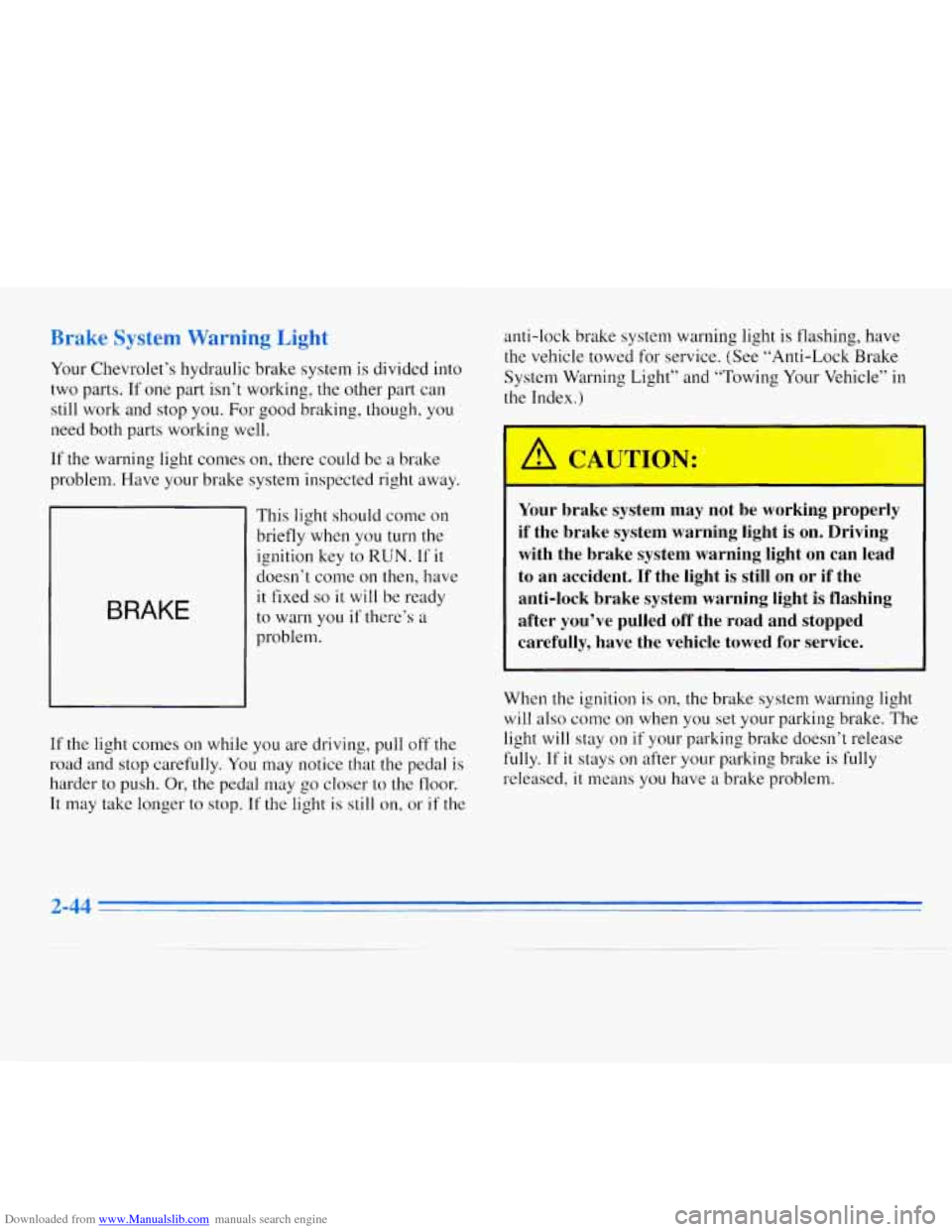Page 73 of 340

Downloaded from www.Manualslib.com manuals search engine AUTOMATIC OVERDRIVE (0): This position is for
normal driving.
If you need more power for passing, and
you’re:
Going less than 35 mph (55 kmk), push your
accelerator pedal about halfway down.
Going about 35 mph (55 km/h) or more, push the
accelerator pedal all the way down.
You’ll
shift down to the next gear and have more power.
NOTICE:
If your vehicle seems to start up rather slowly,
or if it seems not to shift gears
as you go faster,
something may be wrong with
a transaxle system
sensor.
If you drive very far that way, your
vehicle can be damaged.
So, if this happens, have
your vehicle serviced right away. Until then, you
can use SECOND
(2) when you are driving less
than
35 mph (55 kdh) and AUTOMATIC
OVERDRIVE
(0) for higher speeds.
DRIVE
(D): This position is also used for normal
driving, but
it offers more power and lower fuel
economy than AUTOMATIC OVERDRIVE (03).
~~~~
Here are some times you might choose DRIVE (D)
instead of AUTOMATIC OVERDRIVE (0):
When driving on hilly, winding roads.
0 When towing a trailer, so there is less shifting
between gears.
When going down a steep hill.
SECOND (2): This position gives you more power but
lower
fuel economy. You can use SECOND (2) on hills.
It can help control your speed
as you go down steep
mountain roads, but then you would also want
to use
your brakes off and on.
NOTICE:
Don’t drive in SECOND (2) for more than 25 miles
(41 km) at speeds over 55 mph (88 kmk), or you
can damage your transaxle. Use DRJYE
(D)
or AUTOMATIC OVERDRIVE (03) as much
as possible.
Don’t shift into SECOND
(2) unless you are going
slower than
65 mph (105 km/h), or you can
damage your engine.
2-1
Page 75 of 340
Downloaded from www.Manualslib.com manuals search engine NOTICE:
Driving with the parking brake on can cause
your
rear brakes to overheat. You may have to
replace them, and you could also damage other
parts of your vehicle.
If you are towing a trailer and are parking on any hill,
see “Towing a Trailer” in the Index. That section shows
what to do first to keep
the trailer from moving.
Shifting Into PARK (P)
It can be dangerous to get out of your vehicle if
the shift lever is not fully in
PARK (P) with the
parking brake firmly set. Your vehicle can roll.
If you have left the engine running, the vehicle
can move suddenly. You or others could be
injured. To be sure your vehicle won’t move, even
when you’re on fairly level ground, use the steps
that follow.
If you’re pulling a trailer, see
“Towing a Trailer” in the Index.
2-17
. ~. - -
Page 76 of 340
Downloaded from www.Manualslib.com manuals search engine Column Shift
1. Hold the brake pedal down with your right foot and
2. Move the shift lever into PARK (P) position like this:
set the parking brake.
r
0 Move the lever up as far as it will go.
3. Move the ignition key to LOCK.
4. Remove the key and take it with you. If you can
leave
your vehicle with the ignition key in your
hand, your vehicle is in PARK (P).
0 Pull the lever toward you.
2-18
Page 77 of 340

Downloaded from www.Manualslib.com manuals search engine Console Shift
1. Hold the brake pedal down with your right foot and
2. Move the shift lever into PARK (P) position like this:
set the parking brake.
Hold in the button on the
lever, and push the lever all
the way toward the front of
your vehicle.
3. Move the ignition key to LOCK.
I , 4. Remove the key and take it with you. If you can
leave your vehicle with the ignition key in your
hand, your vehicle is in PARK (P).
Leaving Your Vehicle With the
Engine Running
It can be dangerous to leave your vehicle with
the engine running. Your vehicle could move
suddenly
if the shift lever is not fully in PARK (P)
with the parking brake firmly set. And, if you
leave the vehicle with the engine running, it could
overheat and even catch fire.
You or others could
be injured. Don’t leave your vehicle with the
engine running unless you have to.
If you have to leave your vehicle with the engine
running, be sure your vehicle is in
PARK (P) and your
parking brake is firmly set before you leave it. After
you’ve moved the shift lever into the PARK
(P)
position, hold the regular brake pedal down. Then, see
if you can move the shift lever away from PARK
(P)
without first pulling it toward you (or, if you have the
console shift lever, without first pushing the button). If
you can,
it means that the shift lever wasn’t fully locked
into PARK
(P).
2-19
Page 80 of 340

Downloaded from www.Manualslib.com manuals search engine Running Your Engine While
You’re
Parked
It’s better not to park with the engine running. But if you
ever have
to, here are some things to know.
Idling the engine with the air system control
off could allow dangerous exhaust into
your vehicle (see the earlier Caution under
“Engine Exhaust”).
Also, idling in a closed-in place can let deadly
carbon monoxide
(CO) into your vehicle even if
the fan switch is at the highest setting. One place
this can happen is
a garage. Exhaust -- with
CO
-- can come in easily. NEVER park in a
garage with the engine running.
Another closed-in place can be a blizzard.
(See
“Blizzard” in the Index.)
It can be dangerous to get out of your vehicle if
the shift lever is not fully in PARK (P) with the
parking brake firmly set..Your vehicle can roll.
Don’t leave your vehicle when the engine
is
running unless you have to. If you’ve left the
engine running, the vehicle can move suddenly.
You or others could be injured.
To be sure your
vehicle won’t move, even whed yod’re on fairly
level ground, always set your parking brake and
move the shift lever to
PARK (P).
Follow the proper steps to be sure your vehicle won’t
move. See “Shifting Into
PARK (P)” in the Index.
If you are parking on a hill and if you’re pulling a
trailerealso see “Towing a Trailer” in the Index.
2-22
Page 83 of 340

Downloaded from www.Manualslib.com manuals search engine Turn Signal and Lane Change Indicator
The turn signal has two upward (for right) and two
downward (for left) positions. These positions allow you
to signal a turn or a lane change.
To signal a turn, move the lever all the way up or down.
When the turn is finished,
the lever will retum automatically.
A
An arrow on the instrument
panel will flash
in the
direction of the
turn or
lane change.
To signal a lane change, just raise or lower the lever
until the arrow starts to flash. Hold it there until you
complete your lane change. The lever will return by
itself when you release it.
As you signal a turn or a lane change, if the arrow
flashes fdster than
normal, a signal bulb may be burned
out and other’drivers won’t see your turn signal.
If a bulb is burned out, replace
it to help avoid an
accident. If the arrows don’t go on at all when
you
signal a turn, check for burned-out bulbs and check the
fuse (see “Fuses and Circuit Breakers” in the Index).
Headlamp HighLow Beam
To change your headlamps
from low beam to high
beam, or high to low, pull
the multifunction lever all
the way toward you. Then
release
it. When the high
beams are on, a light on
the instrument panel also
will be on.
Page 91 of 340
Downloaded from www.Manualslib.com manuals search engine Mirrors
Adjust all the mirrors so you can see clearly when you
are sitting in a comfortable driving position.
Inside DayNight Rearview Mirror
To reduce glare from lamps behind you, push the lever
forward (to the night position).
To return the mirror to
the day position, pull the lever toward you.
Power Outside Mirrors
The electric mirror control
is on the driver's door. Turn
the control to the left to
adjust
the left mirror or to
the right to adjust the right
mirror. Then move the
control in the direction you
want to'move the mirror.
2-33
Page 102 of 340

Downloaded from www.Manualslib.com manuals search engine Brake System Warning Light
Your Chevrolet’s hydraulic brake system is divided into
two parts. If one part isn’t working, the other part can
still work and stop you. For good braking, though, you
need both parts working well.
If the warning light comes on, there could be
a brake
problem. Have your brake system inspected right away.
BRAKE
This light should come on
briefly when you turn the
ignition key
to RUN. If it
doesn’t come on then, have
it fixed so it will be ready
to warn you
if there’s a
problem.
If the light comes on while you are driving, pull
off the
road and stop carefully.
You may notice that the pedal is
harder to push. Or, the pedal may go closer to the floor.
It may take longer to stop.
If the light is still on, or if the anti-lock brake system warning light
is flashing, have
the vehicle towed for service. (See “Anti-Lock Brake
System Warning Light” and “Towing Your Vehicle” in
the Index.)
A
I
Your brake system may not be working properly
if the brake system warning light is on. Driving with the brake system warning light on can lead
to an accident. If the light is still on or if the
anti-lock brake system warning light is flashing
after you’ve pulled off the road and stopped
carefully, have the vehicle towed for service.
When the ignition is on, the brake system warning light
will also come on when you set your parking brake. The
light will stay on if your parking brake doesn’t release
fully. If it stays on after your parking brake is fully
released, it means you have a brake problem.
2-44